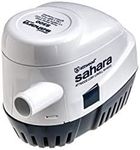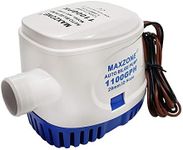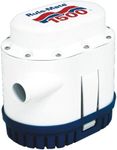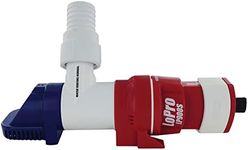Buying Guide for the Best Automatic Bilge Pumps
Choosing the right automatic bilge pump for your boat is crucial for maintaining safety and preventing water accumulation. An automatic bilge pump is designed to remove water from the bilge area of your boat without manual intervention. To make an informed decision, you need to understand the key specifications and how they relate to your specific needs. Here are the main factors to consider when selecting an automatic bilge pump.Flow Rate (GPH)Flow rate, measured in gallons per hour (GPH), indicates how much water the pump can move in an hour. This is important because it determines how quickly the pump can remove water from your boat. Pumps with a flow rate of 500-1000 GPH are suitable for smaller boats or light water conditions, while larger boats or those in rougher waters may require pumps with 2000 GPH or more. Choose a flow rate based on the size of your boat and the typical water conditions you encounter.
Power SourceAutomatic bilge pumps are typically powered by your boat's battery. It's important to ensure that the pump's voltage matches your boat's electrical system, usually 12V or 24V. Additionally, consider the power consumption of the pump, as higher power usage can drain your battery faster. Match the pump's power requirements with your boat's electrical capacity to ensure reliable operation.
Activation MethodAutomatic bilge pumps can be activated by either a built-in float switch or an electronic water sensor. A float switch activates the pump when water reaches a certain level, while an electronic sensor detects water presence and activates the pump. Float switches are simple and reliable, but electronic sensors can offer more precise control. Choose the activation method based on your preference for simplicity or precision.
Construction MaterialThe construction material of the bilge pump affects its durability and resistance to corrosion. Common materials include plastic, stainless steel, and marine-grade alloys. Plastic pumps are lightweight and affordable but may not be as durable as metal options. Stainless steel and marine-grade alloy pumps offer better corrosion resistance and longevity, making them ideal for saltwater environments. Select a material that matches the conditions your boat will be exposed to.
Size and InstallationThe size of the bilge pump and its ease of installation are important considerations. Ensure that the pump fits in the available space in your bilge area and that it can be easily installed and maintained. Some pumps come with mounting brackets or kits to simplify installation. Choose a pump that fits your boat's layout and can be installed without extensive modifications.
Manual OverrideA manual override feature allows you to activate the pump manually, providing an extra layer of control in case the automatic system fails. This is important for ensuring that you can still remove water from your boat in an emergency. Look for a pump with a manual override switch to enhance safety and reliability.






















